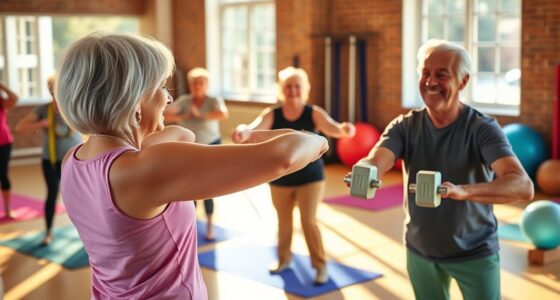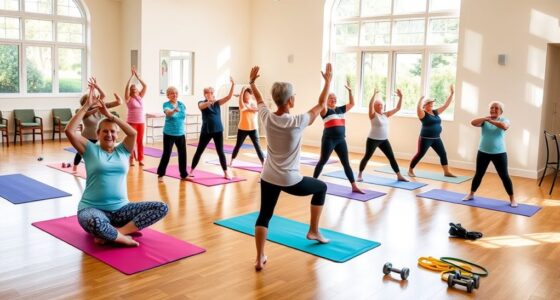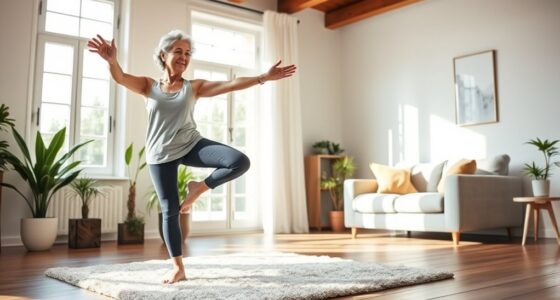Pilates can truly change your life forever as a senior. It improves your core strength, balance, and flexibility, helping you maintain independence in daily activities. With regular practice, you can also enhance your mood and boost cognitive function. Plus, engaging in targeted exercises like side stretches and core work promotes better posture and reduces discomfort. You’ll discover how these techniques can transform your well-being, and there’s so much more valuable information to explore ahead.
Key Takeaways
- Improved core strength enhances balance and stability, significantly reducing fall risks for seniors.
- Increased flexibility from Pilates promotes mobility, helping seniors maintain independence in daily activities.
- Regular Pilates practice supports mental health, contributing to emotional regulation and cognitive function.
- Consistent engagement in Pilates alleviates back pain and improves posture, leading to better body alignment.
- Establishing a regular Pilates routine fosters overall health, boosts energy levels, and enhances quality of life.
The Benefits of Pilates for Seniors
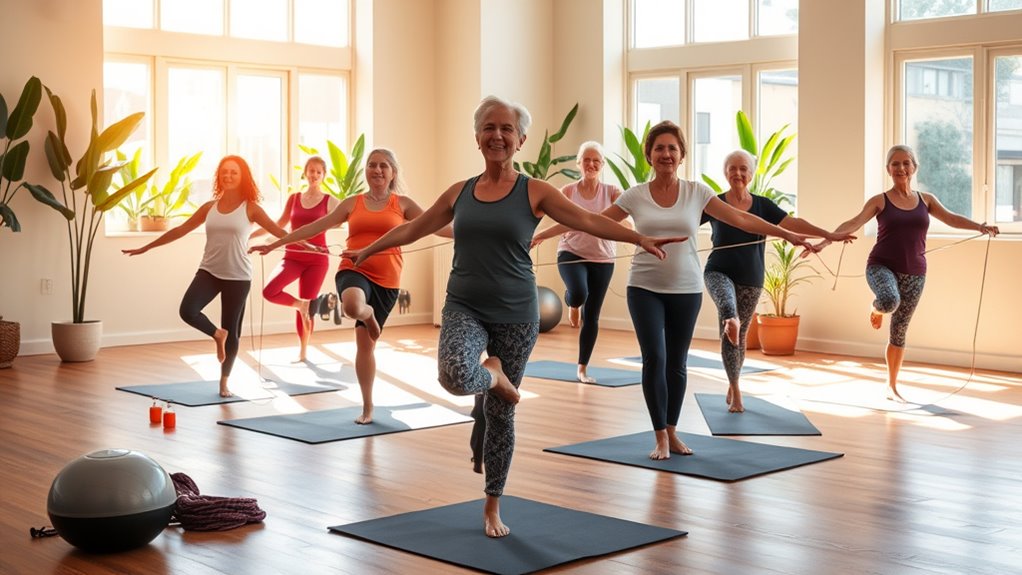
When you incorporate Pilates into your routine, you can experience a range of benefits that greatly enhance your quality of life as a senior.
Every day, you’ll notice improved core strength and stability, essential for maintaining balance and reducing fall risks. Regular practice can boost your flexibility by up to 30%, helping you stay mobile and independent in daily activities. Engaging in physical activities like Pilates can also contribute to emotional regulation, positively impacting your mental health as you age. Studies show that mindfulness practices can significantly reduce anxiety and enhance focus, making it easier to overcome fear of being alone and foster personal growth. Additionally, regular physical activity is linked to improved cognitive function, which can further support your overall well-being.
You’ll also enjoy better posture, which can alleviate back pain and improve body alignment for functional movement. The low-impact nature of Pilates makes it accessible, allowing you to strengthen muscles while promoting joint health.
Plus, focusing on mindful movement and breathing can enhance your mental well-being, reducing stress and lifting your overall mood every day. Additionally, incorporating hydration and nutrition into your routine can further support your overall health and energy levels.
Understanding Core Engagement
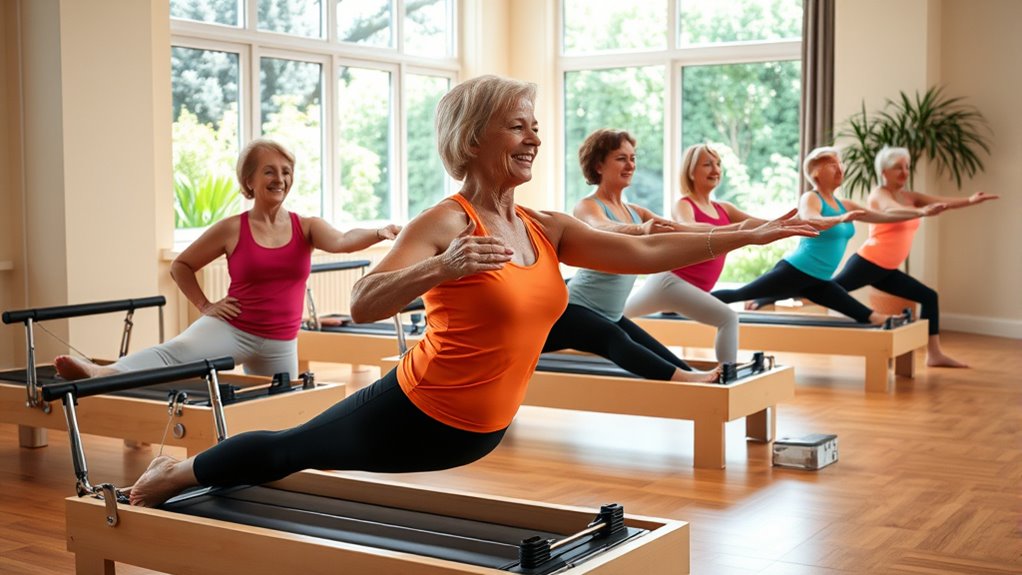
Understanding core engagement is essential for enhancing your stability and balance, especially as you age.
By activating the muscles around your abdomen and lower back, you can improve your posture and reduce the risk of falls. Engaging in various brewing methods can also inspire a mindful approach to physical activity, promoting overall wellness. Additionally, incorporating antioxidant-rich foods into your diet can further support your cognitive function and overall health as you practice Pilates. Furthermore, regular maintenance of your physical routines can enhance your performance and longevity in practice. To achieve your fitness goals, consider developing a comprehensive business plan that outlines your objectives and strategies. Regularly trimming your nails can also be an important part of maintaining your overall health and preventing injuries during physical activity.
Let’s explore some effective techniques to strengthen your core and boost your overall movement in daily activities.
Importance of Core Strength
Core strength plays an essential role in your overall stability and balance, especially as you age. A strong core helps prevent falls by enhancing your stability and mobility. Engaging these muscles supports proper posture, reducing the risk of back pain and improving your body alignment during daily activities. With a strong core, you’ll find that you can move more efficiently, allowing you to perform tasks with less effort and greater ease. This promotes your independence in daily living.
Studies show that regular core engagement exercises improve functional fitness levels in older adults, which can greatly enhance your quality of life. Additionally, professional help can be beneficial for those struggling with emotional challenges that may affect their physical activity. Ultimately, strong core muscles provide a stable foundation for all bodily movements, encouraging safer participation in physical activities. Furthermore, creativity can be cultivated through various exercises, fostering not only physical but also mental well-being. Additionally, maintaining good hearing health is crucial as it supports overall well-being and can enhance your ability to stay active and engaged in your surroundings. Engaging in regular exercise can also promote quality sleep, which is vital for mental health and overall wellness. As AI technology continues to evolve, it is important to understand its implications on health and wellness, especially for seniors.
Techniques for Core Engagement
While engaging your core may seem challenging at first, mastering a few simple techniques can greatly enhance your stability and balance.
Start with deep breathing—inhale deeply to fill your lungs, then exhale while pulling your belly button inward. This action not only strengthens your abdominal muscles but also improves overall body alignment. Additionally, maintaining a strong core can help prevent falls, which is especially important for seniors, as proper posture can significantly reduce the risk of injury during physical activities. Regular exercise, including Pilates, has been shown to improve overall body stability, which can be crucial for maintaining balance. Engaging in mindful movement practices like Pilates can also foster emotional resilience, aiding in coping with challenges.
To deepen your awareness, place your hands on your ribcage and abdomen as you breathe, feeling the rise and fall. Practicing these techniques regularly will enhance your core engagement, making daily tasks easier and safer.
Remember, a strong core helps maintain proper posture and prevents falls, ultimately boosting your quality of life. Additionally, engaging in physical activities like Pilates can help alleviate feelings of anxiety or insecurity related to aging and maintain overall well-being.
Safe Chair Positioning for Optimal Alignment
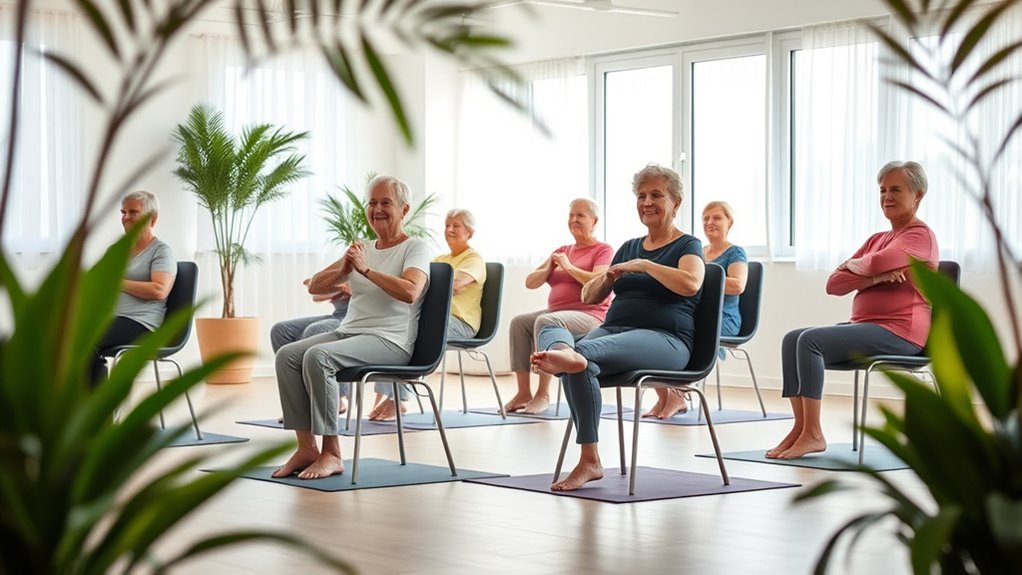
To achieve ideal alignment during Pilates exercises, it’s essential to confirm your chair setup promotes balance and comfort.
Sit evenly on the chair with both sitting bones firmly placed to maintain stability. Adjust the chair height so your knees are aligned with your hip bones, preventing strain and confirming comfort. Your feet should be in line with your knees, aligning the second toe with your ankle joints to support symmetry during movements. Incorporating air quality considerations into your practice space can enhance your overall comfort and performance. Regularly grooming your pets can also help reduce shedding significantly and create a cleaner environment for your practice. Additionally, maintaining optimal usage timing of your air purifier can further improve air quality while you exercise.
Sit up tall with an elongated spine, enhancing your posture, breathing capacity, and core engagement throughout the workout. Additionally, ensuring proper drainage features in your exercise space can help maintain a comfortable environment conducive to your practice. Understanding the importance of self-protection strategies during your practice can further enhance your overall experience.
Regularly check your alignment to confirm your body stays in a neutral position, reducing injury risk and maximizing the benefits of your Pilates practice.
Essential Foot and Ankle Exercises
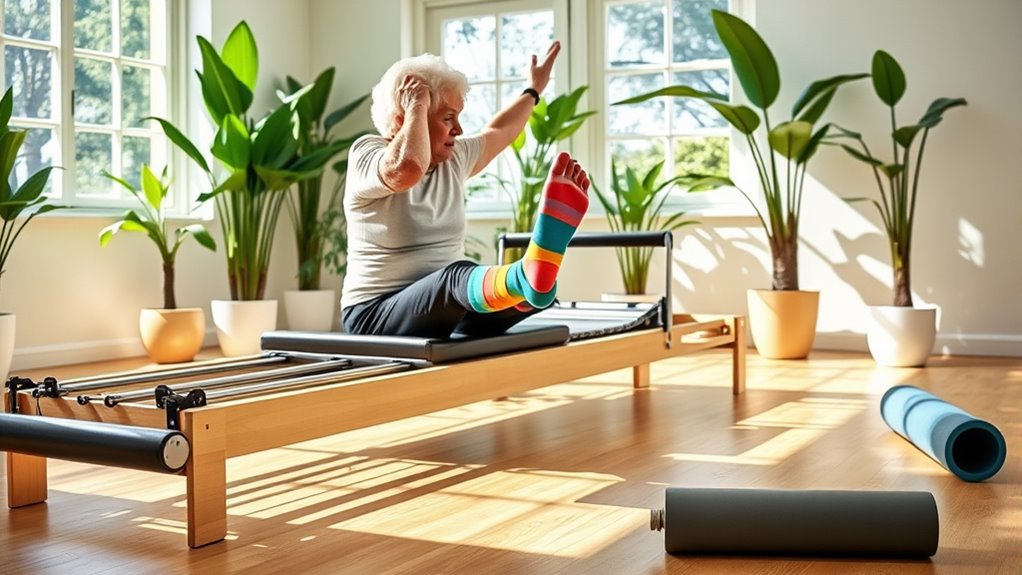
To keep your feet and ankles strong, it’s important to incorporate essential exercises like toe lifts, heel raises, and ankle mobility routines into your routine. These movements not only enhance balance and stability but also improve circulation and flexibility. Additionally, engaging in educational toys can encourage movement and playfulness, enhancing your overall physical well-being. Regular exercise can also support better heart health, contributing to an active and healthy lifestyle. Incorporating whole foods into your diet can further support your physical activity by providing the necessary nutrients for recovery and energy.
Toe Lifts Technique
When you’re looking to enhance your balance and coordination, toe lifts are a simple yet effective exercise to include in your routine. To perform toe lifts, sit with your feet flat on the ground, lift your toes while keeping your heels grounded, and lower them back down. Aim for 10-15 repetitions to engage those vital intrinsic foot muscles.
Here’s a quick overview of the benefits of toe lifts:
| Benefit | Description |
|---|---|
| Improved Balance | Engages foot muscles for better stability |
| Enhanced Circulation | Boosts blood flow in feet and lower legs |
| Strengthened Foot Arches | Alleviates discomfort from flat feet |
Incorporating toe lifts can also warm you up for more advanced exercises, helping prevent injuries.
Heel Raises Benefits
Building on the benefits of toe lifts, heel raises are another fantastic exercise for seniors looking to improve their foot and ankle strength.
These exercises strengthen your calf muscles, which are essential for maintaining balance and stability, especially as you age. By adding heel raises to your routine, you’ll enhance ankle flexibility and range of motion, reducing stiffness in your lower legs.
You’ll also boost circulation in your feet, promoting overall foot health and minimizing the risk of swelling or varicose veins. Regularly practicing heel raises activates the muscles in your feet and ankles, leading to better alignment and posture.
Plus, you’ll develop proprioception, helping you stay aware of your body position and movements, which is important for preventing falls.
Ankle Mobility Exercises
Ankle mobility exercises are essential for seniors who want to maintain balance and stability as they age.
These exercises strengthen the muscles around the ankle joint, helping to prevent falls.
Here are three effective ankle mobility exercises you can incorporate into your routine:
- Heel Lifts: Stand or sit and lift your heels off the ground, then slowly lower them back down. This improves flexibility and strength.
- Toe Raises: From the same position, lift your toes while keeping your heels on the ground. This enhances your balance and foot function.
- Ankle Circles: While seated, extend one leg and rotate your ankle in circles. This increases range of motion and circulation, beneficial for stiffness.
Regular practice can greatly enhance your quality of life.
Strengthening Your Core With Breath
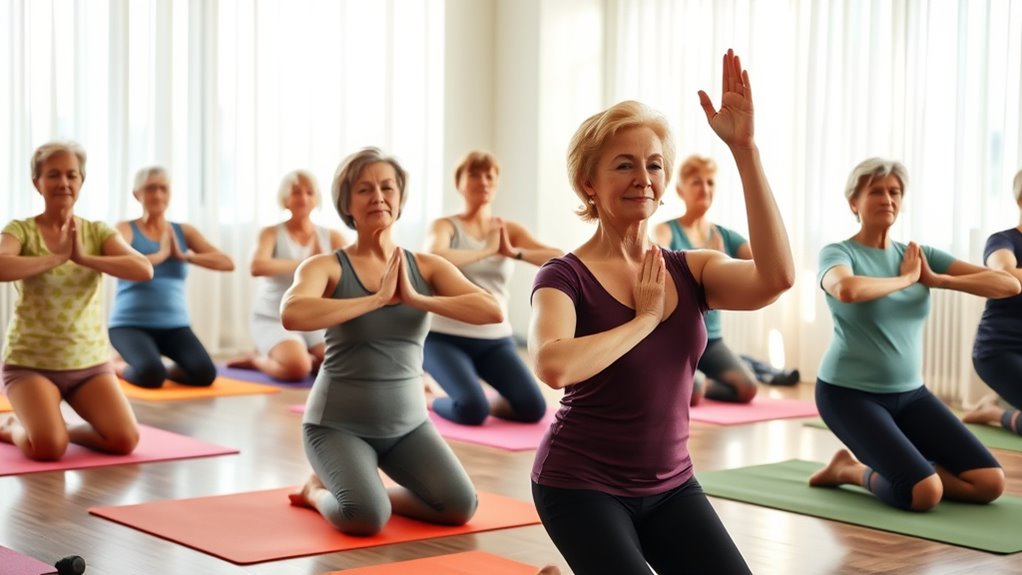
Although many may not realize it, strengthening your core can start with something as simple as your breath.
Begin by taking a deep inhalation to expand your ribcage, which enhances oxygen intake and activates your core muscles. Place your hands on your ribcage to feel the expansion and contraction, reinforcing the connection between breath and core engagement.
As you exhale, actively pull your belly button inward to strengthen those core muscles, improving your posture and stability while sitting. Practicing breathing techniques through your mouth encourages diaphragm and abdominal muscle use.
Combine breath with movement—like lifting your arms while inhaling and curling forward while exhaling—to maximize the effectiveness of your core exercises and promote overall body alignment.
Enhancing Spinal Flexibility and Strength
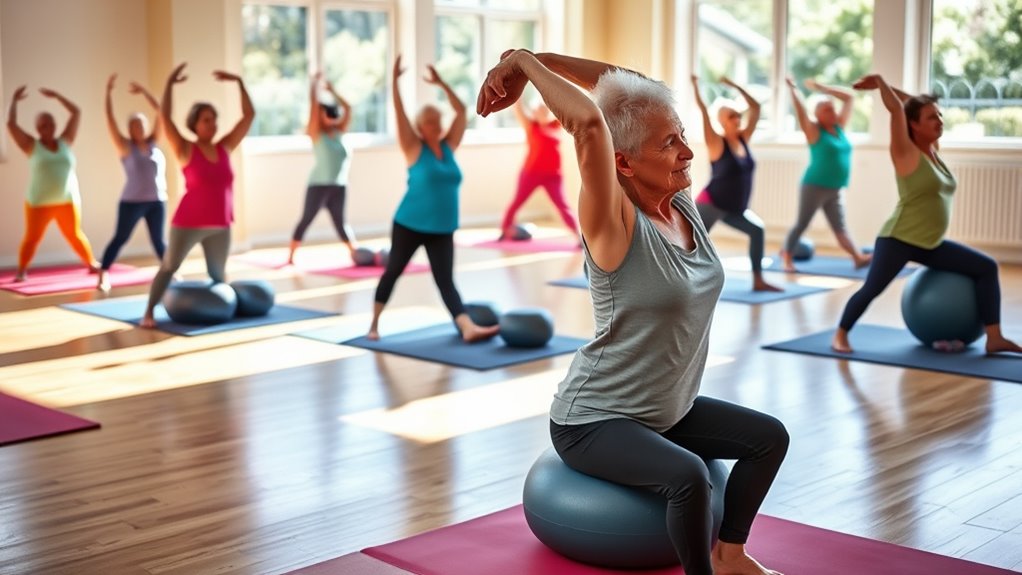
To enhance your spinal flexibility and strength, start incorporating spinal mobility exercises into your routine.
Engaging your core during these movements not only supports your spine but also promotes better overall alignment.
You’ll soon notice improved posture and greater ease in your daily activities.
Spinal Mobility Exercises
As you age, maintaining spinal mobility becomes essential for your overall well-being. Engaging in spinal mobility exercises not only enhances flexibility and strength but also promotes proper alignment and reduces stiffness in your spine.
Here are three key exercises to incorporate into your routine:
- Seated Spinal Curl and Extension: This movement improves circulation to your spinal discs, supporting spinal health.
- Spinal Rotations: Regularly practicing these can increase your thoracic spine’s range of motion, improving posture and reducing fall risks.
- Spinal Flexion and Extension: These exercises strengthen core muscles, providing essential support for your spine and alleviating back pain.
Core Engagement Techniques
Building on the foundation of spinal mobility exercises, core engagement plays an essential role in enhancing both spinal flexibility and strength.
To engage your core effectively, pull your belly button inwards as you exhale; this strengthens your abdominal muscles and supports spinal alignment. Practicing deep breathing while placing your hands on your ribcage lets you feel rib expansion, improving oxygen intake and core activation.
Incorporate spinal movements, like curling your spine forward and extending your head, to reinforce flexibility and strengthen your spinal muscles. Regular rotation exercises, where your ribcage gently rotates while engaging your core, enhance spinal mobility and promote better posture.
Combine core engagement with movements like leg lifts or shoulder rolls to boost coordination and functional strength for daily activities.
Incorporating Rotation for Mobility
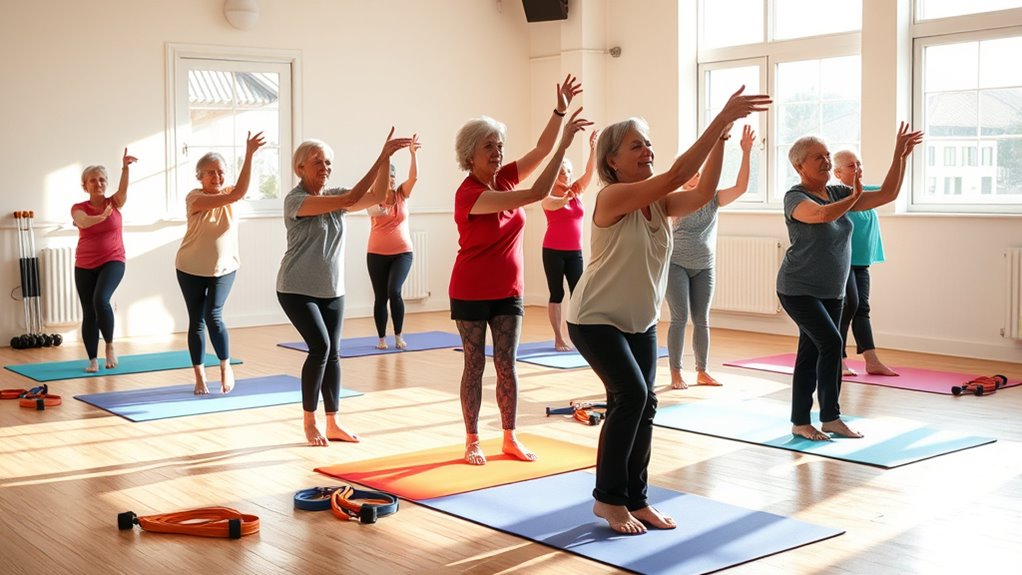
Incorporating rotational exercises into your seated Pilates routine can greatly enhance your spinal mobility, essential for maintaining flexibility as you age.
These gentle movements not only improve your range of motion but also strengthen your core, supporting better posture and stability.
Gentle rotational exercises enhance your flexibility while strengthening your core for improved posture and stability.
Here are three key benefits of adding rotation to your practice:
- Enhanced circulation: Rotational movements boost blood flow, which can aid digestion and overall well-being.
- Reduced tension: Regularly performing these exercises can alleviate discomfort in your back and shoulders, promoting comfort in daily activities.
- Increased body awareness: Engaging in rotations helps you understand your physical capabilities, fostering confidence and independence as you navigate your daily life.
Try incorporating these exercises to experience the benefits firsthand!
The Importance of Side Stretches

While many people focus on forward and backward movements in their exercise routines, side stretches play a crucial role in enhancing lateral flexibility and mobility. By incorporating these stretches into your routine, you can prevent stiffness and improve overall body movement. Regular side stretching alleviates tension in your shoulders and back, promoting better posture and reducing discomfort.
| Benefits of Side Stretches | Effects on Seniors |
|---|---|
| Improves lateral flexibility | Enhances daily movement |
| Promotes spinal alignment | Reduces injury risk |
| Increases circulation and energy | Boosts overall liveliness |
| Fosters body awareness | Aids balance and coordination |
Embrace side stretches to support your health, enhance liveliness, and enjoy a more active lifestyle.
Relieving Tension With Shoulder Movements
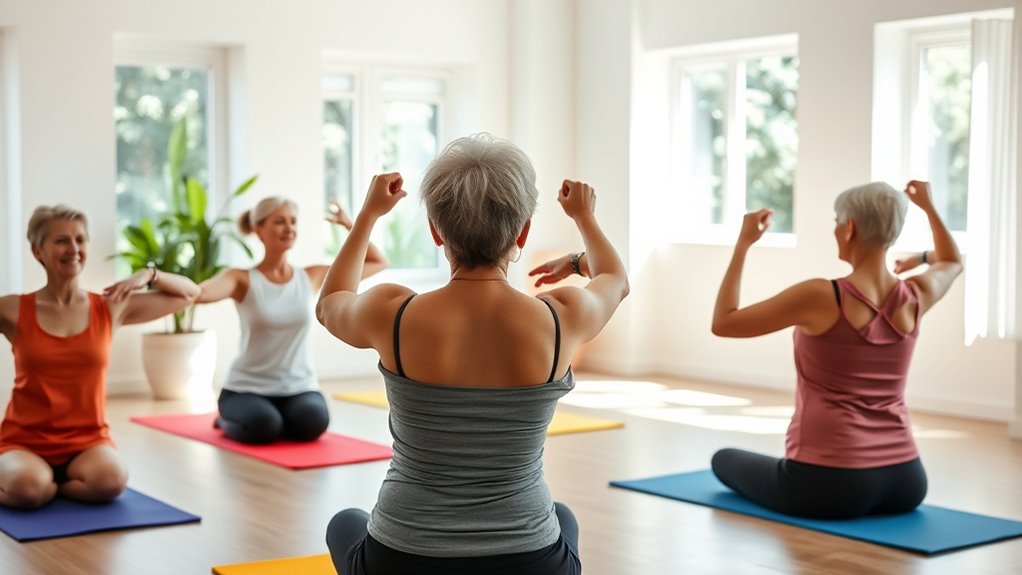
Shoulder movements are key to relieving tension in your upper body, allowing you to feel more relaxed and mobile. Incorporating these movements into your Pilates routine can enhance your overall well-being.
Here are three effective shoulder exercises to get you started:
- Shoulder Rolls: Roll your shoulders up, back, and around to alleviate stiffness and boost circulation.
- Elbow Lifts: Bring your elbows together, then lift them to improve posture and ease discomfort from sitting too long.
- Hands on Shoulders: Place your hands on your shoulders to increase awareness and control, helping you achieve deeper stretches.
Consistent practice of these movements will improve your range of motion and reduce injury risk, making daily activities easier and more enjoyable.
Creating a Consistent Pilates Routine
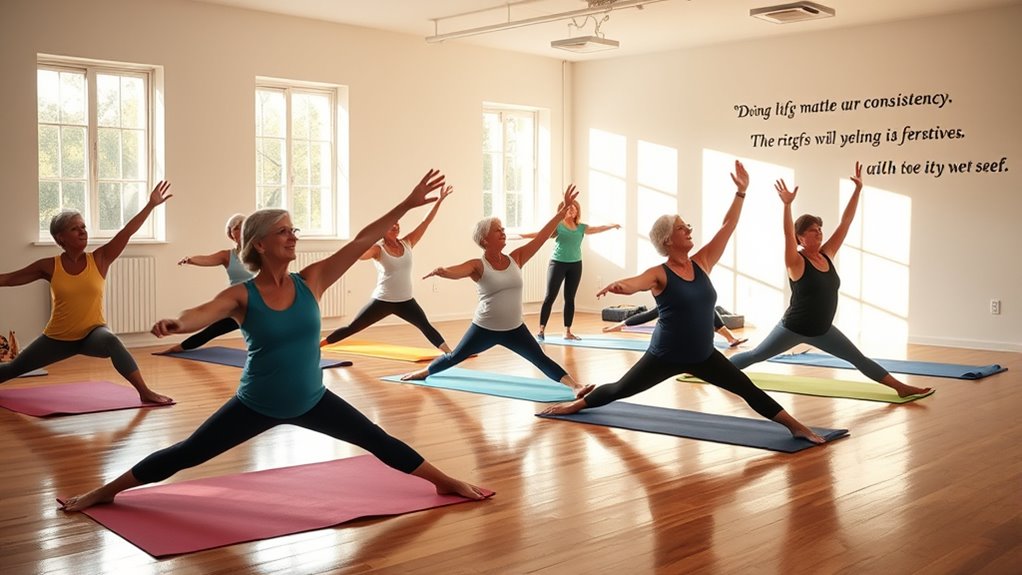
After you’ve relieved tension with shoulder movements, establishing a consistent Pilates routine can take your upper body benefits to the next level.
Aim for at least 2-3 sessions per week to effectively build strength and flexibility over time. Start each session with a 5-10 minute warm-up to prepare your muscles and joints, enhancing performance and reducing injury risk.
Mix in a variety of exercises that target different muscle groups to keep your routine engaging and promote balanced strength development. Track your progress by noting improvements in your range of motion and overall well-being; this can motivate you to stay consistent.
Joining a group class or an online community can also provide accountability and support, helping you remain committed to your practice.
Frequently Asked Questions
Is 70 Too Old to Start Pilates?
No, 70 isn’t too old to start Pilates! In fact, it’s a great time to begin.
You’ll find that Pilates focuses on low-impact movements, which can easily adapt to your fitness level. Engaging in Pilates can enhance your balance, flexibility, and core strength, helping you maintain independence.
Just remember to consult with a healthcare professional first to confirm the exercises suit your specific needs. You’ll likely feel better and more aligned in your daily activities!
What Is the 80/20 Rule in Pilates?
The 80/20 rule in Pilates means that 80% of your results come from just 20% of the exercises you do.
It encourages you to focus on the most effective movements that enhance your strength, flexibility, and balance.
By prioritizing these key exercises, you can maximize your time and energy, achieving better results without overexerting yourself.
How Often Should a Senior Do Pilates?
Did you know that seniors who practice Pilates 2 to 3 times a week can reduce their risk of falls by up to 30%?
To reap these benefits, you should aim for consistent sessions. Start with 30 to 60 minutes each time, focusing on your core engagement, strength, and flexibility.
As you grow more comfortable, gradually increase the frequency or intensity. This routine can enhance your overall mobility and well-being considerably.
How Long Does It Take for Pilates to Change Your Body?
It typically takes about 4 to 12 weeks of consistent Pilates practice for you to notice changes in your body.
If you commit to 2 to 3 sessions a week, you might see improvements in muscle tone, flexibility, and posture within the first month.
Many practitioners report enhanced core stability and balance fairly quickly, often feeling positive changes in daily activities and movement patterns as they progress through their routine.
Conclusion
Incorporating Pilates into your routine can truly transform your life as a senior. Research shows that regular practice not only enhances flexibility and strength but also boosts mental well-being by reducing stress and anxiety. By focusing on core engagement and mindful movements, you can improve your posture and overall mobility. So, take a step today—embrace Pilates and experience the profound benefits for both your body and mind. Your journey to a healthier, happier you starts now!



